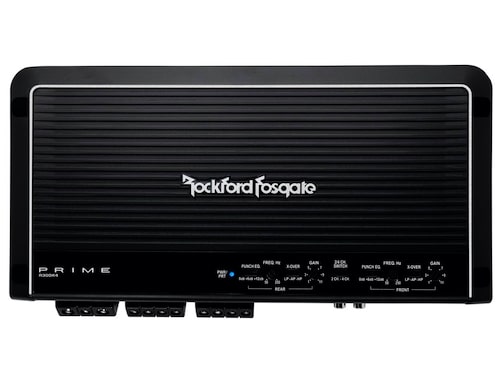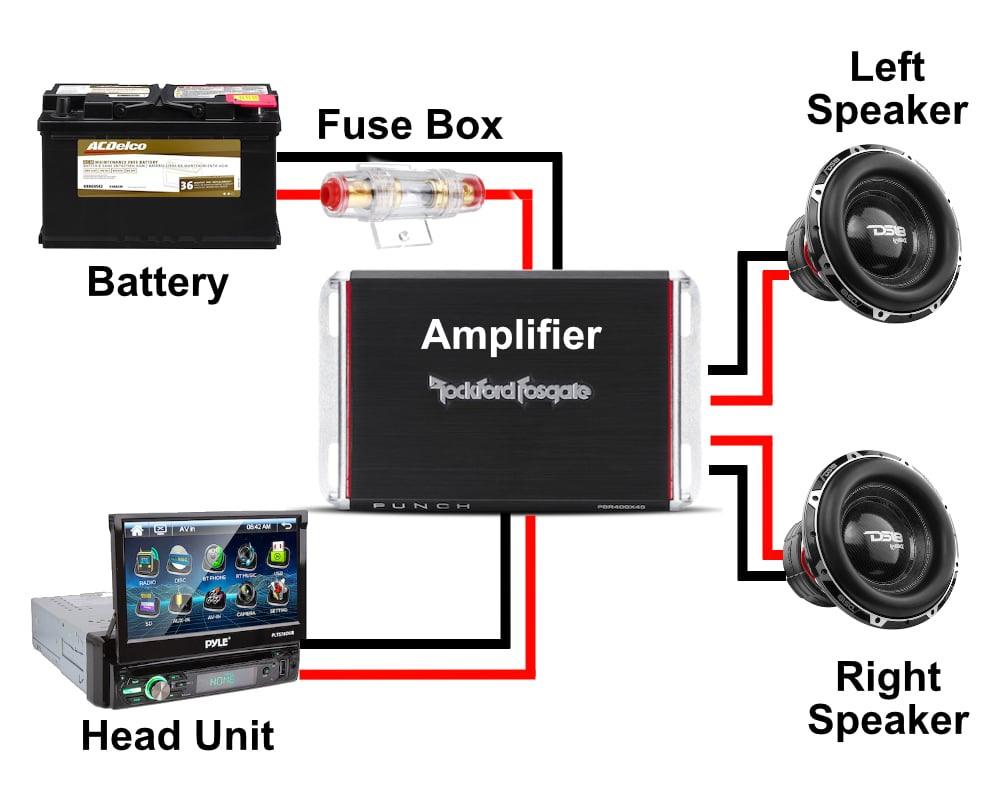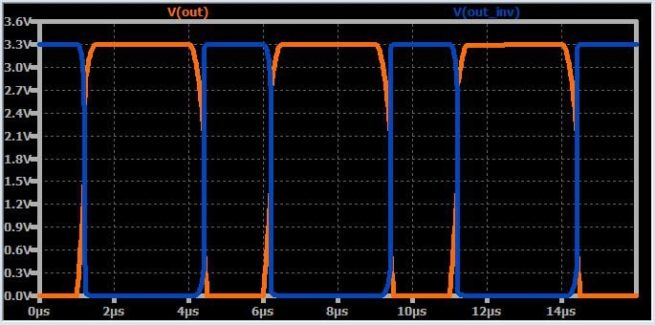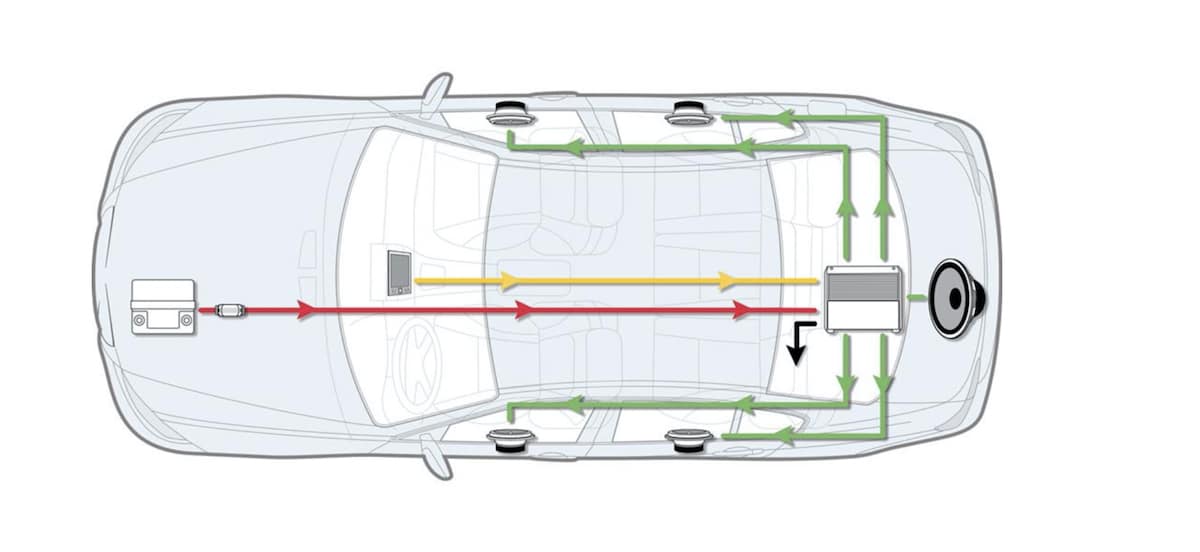What Is a Car Amplifier? How it Works & What it Does? 2023
Simply put, a car amplifier is a device that increases the power of a signal. In the context of car audio, this means amplifying the sound coming from your speakers so you can enjoy your music at a higher volume.
Every sound system has some type of amp already built-in, but if you’re looking to get the most out of your music, you’ll need to add an external amplifier.
This can be a great way to increase the power of your audio systems, but it’s important to understand how they work before making any decisions. We are going to be covering everything you need to know about car amplifiers in this guide.
We’ll start by explaining what they are and how they work, then we’ll discuss the different types of amplifier classes. Finally, after explaining what is a car amplifier, and we’ll give you some tips on choosing the right amplifier for your needs.
What does a car amplifier do?

A car amplifier is an important component of your vehicle’s sound system. It will boost the electrical audio signal from the head unit to a higher voltage, which can drive loudspeakers with more power and clarity in mind.
The output of the typical car audio systems max out at about 15 to 18 watts, and they begin sounding distorted very quickly. A separate amplifier will not only produce a high-quality sound, but it will also eliminate any sound distortion and can even be used to power subwoofers.
The basic principle is that the amplifier will take a small current and then amplify it to a larger one, which can be delivered into the speaker system with less resistance. A regular loudspeaker receives an average of 0.5 amperes (A) at 2 volts (V), but the amplifier can generate up to 100 A at 80 V.
If you are looking to upgrade the front and rear speakers of your car with some aftermarket ones, you will need an amplifier that can put out at least 50 watts RMS per channel. Also, if you want to add a subwoofer to your system, you will need an amplifier that can put out at least 150 watts of RMS.
Some speakers will require more power than others, but you can figure out how much power your speakers need by taking the RMS value of each speaker and multiplying it by two. There are plenty of external car amps with sufficient power to drive a system with multiple speakers and a subwoofer. Make sure that you choose the right one for your car stereo.
How does a car amplifier work?

In order to understand how a car amplifier works, you need to first understand some basic electronics concepts. The simplest way to think about an amplifier is as a device that takes one voltage and turns it into two voltages. This is accomplished by using something called a transistor.
A transistor is basically a switch that can be turned on and off very quickly. When it’s turned on, it allows current to flow through it; when it’s turned off, no current can flow through it. This ability to turn on and off quickly is what allows a transistor to act as an amplifier.
When the transistor is turned on, it behaves like a closed switch (meaning current can flow). When the transistor is turned off, it behaves like an open switch (no current flows). A purely electronic version of this concept would look something like this:

When we send signals into transistors electronically, we call them input signals because they come into the amplifier from another part of the circuit.
The amplified output signal will be at twice (or more) the strength of the input signal; we call these output signals voltage gains because they give us a higher voltage than what we started with. So, where does that extra power come from?
The extra power comes from the battery. When you turn on your car amplifier, it starts drawing power from your car’s battery. This increased demand on the battery can cause the voltage to drop, so be sure to keep an eye on your car’s voltage gauge when you have an amplifier installed.
Now that you understand how a car amplifier works at a basic level, you can make an informed decision about your sound system. If you want to increase the overall volume and audio quality of your music, a car amplifier is exactly what you need.
What is the use of an amplifier in a car?
Amplifiers are used in all music-listening devices, whether it’s your smartphone or hi-fi stereo. Despite what you might imagine, the original signal is not always strong enough to power your speakers at maximum volume.
This is where an amplifier comes into play; it boosts the electrical current of the audio signal coming from your phone/iPod/CD player and sends it on its way to power up your speakers.
For example, at times, your car factory speakers do not have enough power to produce the desired sound. A car amplifier can bridge that gap and power those speakers to a new level, giving you the sonic experience you are looking for.
The amplifier takes the low-power signal from your music player and amplifies it, making it louder. It also changes the waveform of the signal so that the speaker can handle more power without distorting the sound.
A typical car amplifier will have three main sections: input, filter, and output. The input is where you connect the audio source (e.g., phone/iPod/DVD player), while the filter section removes any unwanted noise or distortion from the signal.
The output then sends the amplified signal to your speakers. Regular amps and aftermarket car audio amplifiers come in all shapes and sizes, but the principle behind them is always the same. Most experts choose to go with a multi-channel amplifier to power all the speakers in their sound system at once.
What is a channel on an amp?
An amplifier channel is an independent audio path that is used to create a sound output that has more power and better quality. Most amplifiers have multiple channels, which can be used to power different types of speakers.
For example, a four-channel amplifier could be used to power two front speakers and two rear speakers in your car audio system. This setup would give you better sound quality than if you were using a two-channel amp.
When it comes to choosing an amplifier for your car audio system, the number of channels is an important factor to consider. If you’re not sure how many channels you need, consult with an expert to help you make the right decision.
Different Types of Car Amplifiers

Most car amplifiers that come installed in vehicles have a weak audio signal when they are first produced. That is why an aftermarket amplifier is used to strengthen the sound that goes into your car’s speakers.
Car amps come in various designs and sizes, which is why you need to learn what are the different types of amps that are available on the market. Here we will discuss the amps by classes and by channels so you can get a broad idea of what you can get for your car radio.
Amplifier classes explained
Amp classes are broad categories that amplifiers can be classified into based on their design and features. There are five main classes of amplifiers: A, B, A/B, C, and D.
Class A
These car amps have the simplest design, and they use a single transistor to amplify the signal. They are considered the most efficient because they waste the least amount of power. However, they also have the least amount of power handling and tend to be small in size.
Class B
These amps are more common ones in the industry, and they use two transistors to amplify the signal. They are more powerful than Class A amps, but they are also less efficient and can generate heat.
Class A/B
Class A/B amps are the most popular because they are offered at an affordable price and have good sound quality. Class A/B works similar to class A, but it turns off when your signal reaches a zero voltage threshold, saving power for all you music lovers out there.
Class C
These amplifiers are similar to Class B, but they use three transistors instead of two. They offer higher power output and are more efficient than Class B amps, but they can also be more expensive.
Class D
The class d amplifiers are the most popular type of amplifier, and they use digital technology to amplify the signal. They are very efficient and can produce more power, but they can be expensive.
Also, the class D amp is also known as “digital amplifier” or sometimes called “mono amp” when it only uses a one-channel path. It offers high efficiency and a higher power output thanks to its internal power supply.
Amps by channels explained
Channel is another term that is used when referring to an amplifier. It simply refers to the number of audio signals that an amp can handle at one time. Most amplifiers have multiple channels, which can be used to power different types of speakers.
One channel amplifier
These amps are the simplest type, and they only have one channel that cant power a single speaker. They are the most affordable option and are perfect for people who only need basic amplification.
Plus, it is known as a monoblock amp and for its ability to produce a significant bass boost. For those who are looking to add a subwoofer to their new sound system, a monoblock amp is the way to go.
2 channel amplifiers
This is the most common type of amplifier, and it can be used to power two speakers. It is a good choice for people who want better audio sound without spending too much money. If you are not going to be adding a subwoofer, then this should be a great way to improve your current speaker outputs.
4 channel amplifiers
These car amps are the most common in the industry because they can offer good control over sound quality. It is perfect for music enthusiasts who want more sound punch with higher power handling. If your goal is to achieve a loud sound, then adding a subwoofer and your current speakers to a 4-channel amplifier is the way to go.
5 channel amplifiers
This type of amp offers high-quality audio, but it doesn’t have a subwoofer output. It is designed to power multiple speakers, and it is a good choice for people who want maximum power when it comes to bass boost and audio quality.
How to Choose an Amplifier for Your Car Audio System?
Things like power supply, sensitivity, speaker wiring, and RMS power are some of the most important things to consider when buying an amplifier. Since your car stereo deserves the best, here are some of the essential aspects that are going to help you find the right one for you.
Power Supply
The power supply is what makes an amplifier special. It’s able to efficiently increase electrical energy and make it more powerful for your speakers or other equipment. Amplifiers use SMPSs for their increased efficiency when gaining this vital resource from a 12V source.
Speaker level inputs
Speaker level inputs are the perfect solution for connecting an amplifier to your factory radio or amplifier. The outputs coming from a factory car stereo can be connected to the speaker wiring then plugged into an amp for you not to have any problems when it comes time to make your car sound system more powerful.
Noise prevention
Ground loop noise can be a very frustrating installation problem for car audio systems. It is caused when ground wires from the amplifier often touch each other, creating low-frequency rumbling sounds that many people find annoying and unpleasant to listen to in their vehicles.
What causes this issue? Well, typically, there are two reasons:
- Poor insulation on either side of where these connections meet (the connector).
- Corrosion has eaten away at the metal strands inside due to maybe being exposed to too much moisture or just happening over time because they’re not always properly cared for by car owners, which leads to them deteriorating more quickly than expected.
Some amplifiers come with a filter design called the differential amplifier circuit, which blocks out this noise before it can get into your musical signal pathways.
Low pass filter
A low pass filter is an important thing to have on your amplifier. It blocks out the harmful noise, so it doesn’t get into your music. This way, you’re able to enjoy your music the way it’s supposed to be heard without any distorted sounds.
With a low pass filter, you can eliminate those sounds located on the lower part of the frequency range so that the only thing you’re left with is the clean and clear sound of your audio signal.
Power connections
The power connections are extremely important to get right from the beginning. The installation process for amplifiers often requires the use of power wires that are large enough and have a specific type. If the power wire requirements aren’t met, then your amplifier won’t function properly or at all.
Power output
Amplifiers can be rated by their power output, which is measured in watts. This number tells you how much sound pressure waves will create at your listening position when turned up to full volume.
When the input signal level is strong, amplifier gain adjustment can be used to control its output and make it weaker. This will help match your car stereo’s speakers with how loudly you’re playing music through them so that they don’t overload or distort.
Channels needed
When looking for an amplifier, you need to determine how many channels it has. This number tells you how many speakers the amp can power at the same time. The more channels an amplifier has, the more versatile it will be for your system.
A 2 channel amp is good for a basic system that just needs a bit of power, while a 4 or 5 channel amp can be great for someone who wants to have more control over their sound and add more speakers to their car’s audio setup.
Crossovers
A crossover is a filter that splits up the audio signal into different frequency ranges so each individual speaker can play only the frequencies it can handle. This will help your music to sound full and well-rounded no matter which speakers are being used.
Some amplifiers have built-in crossovers, while others have the option to buy them as an accessory later on if needed. Crossovers are typically placed before the amplifier so that it doesn’t lose any power along the way.
RMS power and Peak power
RMS stands for Root Mean Square, and it’s a way of measuring an amplifier’s continuous power output. It’s very important to find an amplifier that has a high RMS rating because it means that it can handle more power without overheating or damaging its internal components.
Peak power is the maximum amount of power that an amplifier can produce for a short period of time. This number is important to know if you’re looking to buy an amp for a system that will be used in competition or if you just want the biggest, baddest sound possible.
Definition of the Amplifier Power Ratings
The continuous power or RMS ( Root Mean Square ) rating describes how much an amp can deliver reliably. The peak power specification is a technicality, not something you’ll see at normal use.
RMS (Root Mean Square) is the technical term for continuous average power. This is particularly useful when looking at amplifiers as it gives us an idea of how much power our speakers will be receiving. Peak power is a more useful number for car amplifiers than RMS.
The higher the RMS power rating, the more powerful your amplifier will be and, therefore, louder music you can create. The AC voltage is different than the DC current. RMS measurements take that into account, so it’s important to use an accurate device when doing your math and comparing specifications.
The Consumer Electronics Association (CEA) created the CEA 2006 standard to encourage sellers and manufacturers of products such as amplifiers, television sets, etc., by ensuring that their specifications are accurate.
FAQ
Does my car have an amp?
Yes. Most likely, your vehicle’s audio system will come with a built-in amp. If you want to upgrade the performance of your speakers, adding an amp may be a good idea. This is because the amps that come with most head units are relatively low-powered and can’t really push your speakers to their full potential.
What is the difference between Class D and Class A/B amp?
One of the major drawbacks to Class A/B designs is that they conduct, follow and amplify most signals even when nothing is being delivered.
The reason for this behavior has a lot to do with thermal energy lost due to weighting up excess heat during hard use – which makes these amps fairly warm, especially because there’s always some power leftover on their output stages after doing their job so well.
Class D amplifiers are different from class A/B amps in that they only turn on to control the power of components, not deliver sound. The input signal is changed into a series or pseudo-square waves, which the amp then uses for controlling when it’s producing audio output.
The efficiency of a class D amplifier makes them perfect for powering subwoofers. This type is typically 85% or higher, meaning it operates at much lower temperatures than an A/B design and can be significantly smaller too.
Does a car amplifier improve sound quality?
Yes. A car amp does improve the quality of the audio signals. Either if you have new speakers or your stock ones, installing an amplifier will make a difference. Most of the time, the existing amp does not have sufficient power to run new speakers.
So you need to have a car amp installed after the factory one does not provide your speakers with enough power anymore. You will notice the amount of improvement in the sound clarity of both the left and right speakers of your car.
Should I get a 2 channel or a 4 channel amp?
A 2 channel amp is designed to power two speakers, while a 4 channel amp can power four. A 4 channel amp is a better choice if you want to add a subwoofer to your system, as it will provide more power to the bass frequencies.
Can an amplifier blow my speaker?
An amplifier will not blow your speaker if it is properly matched to the impedance of the speaker. In other words, if you buy an amplifier that has an impedance rating that matches the impedance of your speakers, then there is no danger of blowing them. However, if you mismatch the impedance of the amp and the speaker, you could damage or even destroy the speaker.
Do you need an amp for upgraded car speakers?
Most likely, you are going to need to purchase an external car amp to power your upgraded car speakers. If you have a stock head unit, chances are it’s not powerful enough to drive your new aftermarket speakers. Purchasing an external amp will ensure that you’re getting the most out of your new sound system.
Last Car Audio Amplifier Tips and Advice
Out of all audio components, the amplifier is the one that is going to help achieve better audio quality. Upgrading to component speakers is another way to improve the sound in your car, but an amplifier is still a necessary addition for most systems.
Try to match the impedance level of the amplifier with your speakers. Make sure to purchase an amp that has a rating close to the impedance of each speaker. If you are unsure about what impedance is best for your vehicle’s car stereo, consult with an expert before making any purchases.
Last Updated on: January 11, 2023

